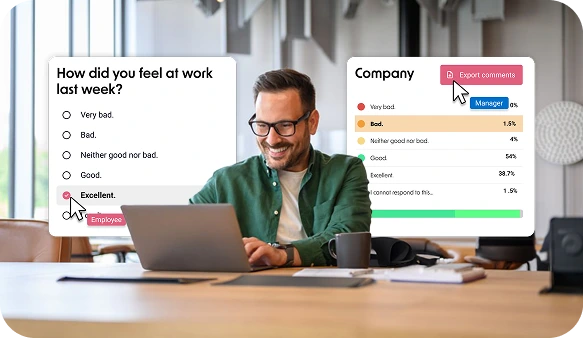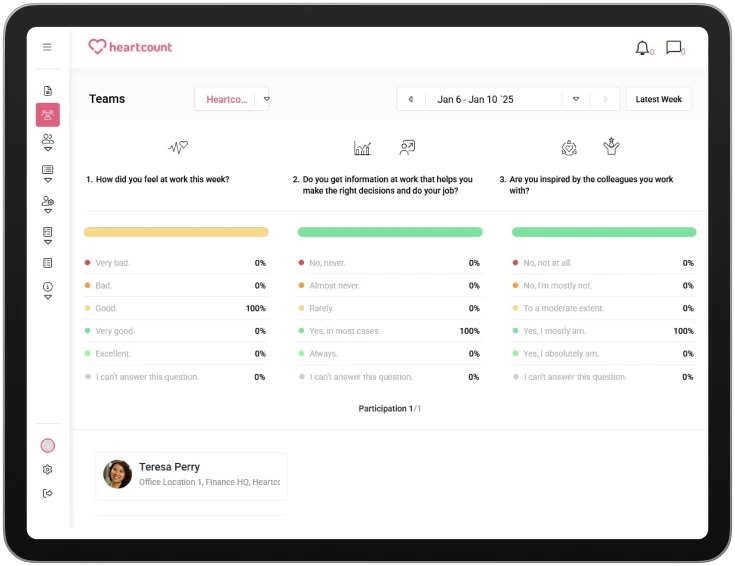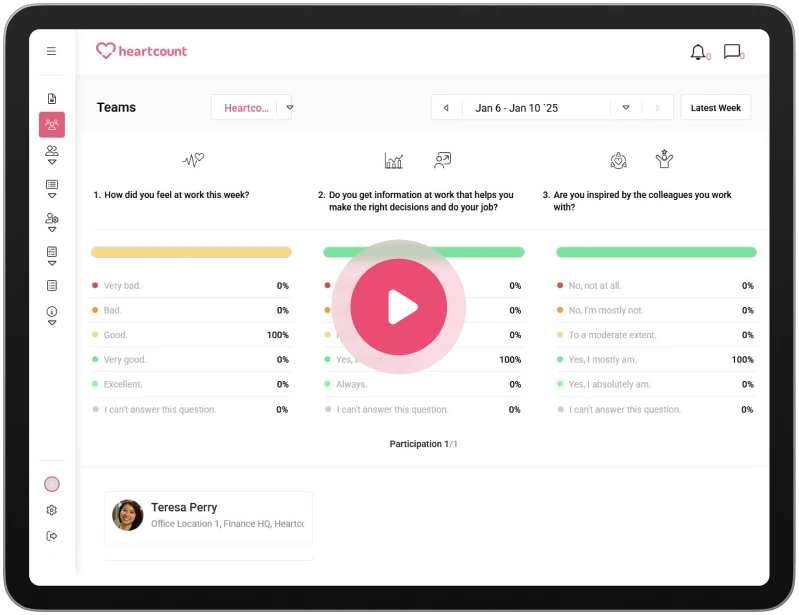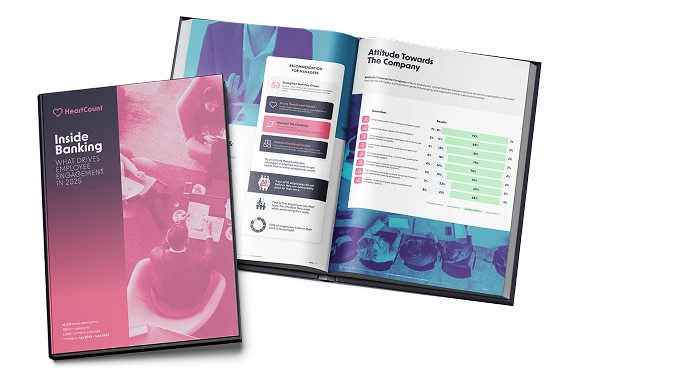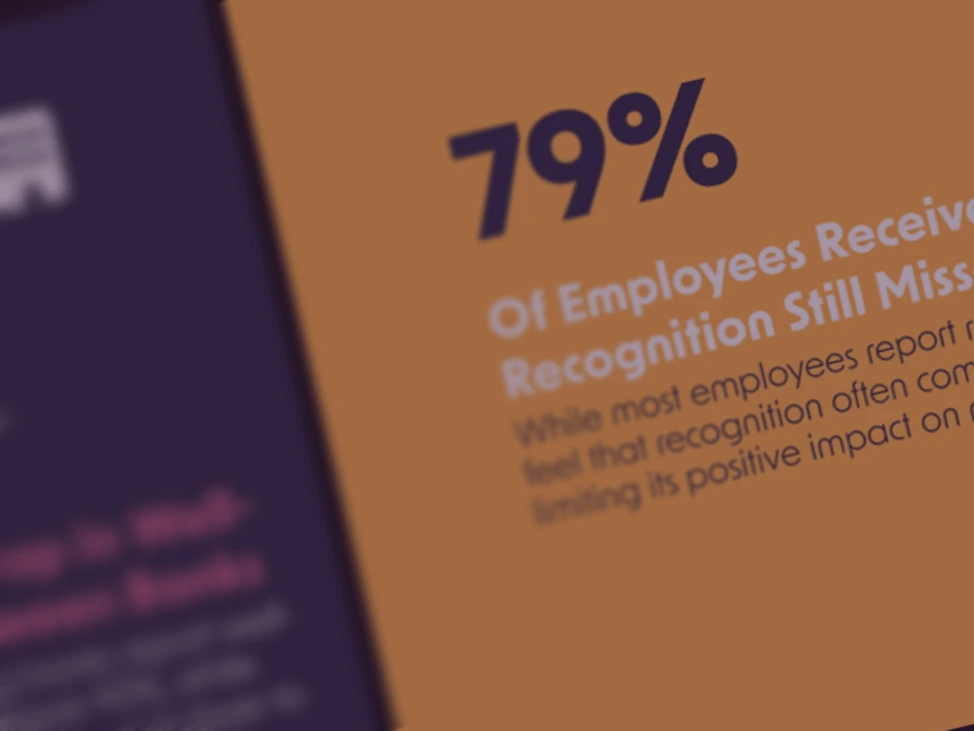Employee Survey Response Rate: What’s Good, Averages & 6 Ways to Improve Participation (2025)

Here’s the hard truth about your employee survey response rate in 2025: getting people to click is harder than it used to be, and it’s not just your company. Across the broader survey world, response rates have been sliding for years, a symptom of survey fatigue and skepticism; for example, Pew documented U.S. phone-survey rates dropping to just 6–7% before the pandemic, a reminder that simply “sending a survey” no longer guarantees representative input.
Inside organizations, there’s another wrinkle: when leaders collect feedback but don’t act, employees notice—and participation drops the next time. Harvard Business Review warns that the gap between listening and visible action “can diminish the value of employee feedback over time,” ultimately causing people to stop responding.
Why should HR care? Because employee experience is now a front-burner priority for executives, and it’s tied to retention outcomes. SHRM reports that nearly half of HR leaders rank employee experience among their top priorities, and a positive experience makes employees far less likely to consider leaving.
In other words: better listening → better decisions → better retention.
This guide breaks down what a good response rate looks like today, the average employee survey response rate you can expect by context, and six evidence-backed ways to lift participation, especially in hybrid and frontline teams, while building trust through action. And when you’re ready to operationalize continuous listening (weekly pulses, real-time analytics, and manager nudges) without heavy lift, HeartCount can help.
-
1.What Is an Employee Survey Response Rate?
-
2.Why Response Rate Matters in Employee Engagement Surveys
-
3.What Is a Good Employee Survey Response Rate?
-
4.6 Actionable Ways to Improve Your Employee Survey Response Rate
-
5.Factors That Influence Response Rates
-
6.Common Mistakes That Lower Employee Survey Response Rates
-
7.Conclusion: Aim for Response, Act on Insight
-
8.FAQs About Survey Response Rates
Here’s the hard truth about your employee survey response rate in 2025: getting people to click is harder than it used to be, and it’s not just your company. Across the broader survey world, response rates have been sliding for years, a symptom of survey fatigue and skepticism; for example, Pew documented U.S. phone-survey rates dropping to just 6–7% before the pandemic, a reminder that simply “sending a survey” no longer guarantees representative input.
Inside organizations, there’s another wrinkle: when leaders collect feedback but don’t act, employees notice—and participation drops the next time. Harvard Business Review warns that the gap between listening and visible action “can diminish the value of employee feedback over time,” ultimately causing people to stop responding.
Why should HR care? Because employee experience is now a front-burner priority for executives, and it’s tied to retention outcomes. SHRM reports that nearly half of HR leaders rank employee experience among their top priorities, and a positive experience makes employees far less likely to consider leaving.
In other words: better listening → better decisions → better retention.
This guide breaks down what a good response rate looks like today, the average employee survey response rate you can expect by context, and six evidence-backed ways to lift participation, especially in hybrid and frontline teams, while building trust through action. And when you’re ready to operationalize continuous listening (weekly pulses, real-time analytics, and manager nudges) without heavy lift, HeartCount can help.
What Is an Employee Survey Response Rate?
Your employee survey response rate shows how many eligible employees actually completed the survey within the fieldwork window. It is the primary signal of representativeness, which means it tells you whether the voices in your dataset reflect the workforce you intended to hear from. Getting this definition right prevents confusion later when leaders compare teams, time periods, or vendors.
Definition and How It’s Calculated
Your response rate is the share of valid completed surveys divided by eligible invited employees.
Formula:
Response rate (%) = (Number of valid completed surveys ÷ Number of eligible employees invited) × 100
What counts as “valid”
- Finished, or “complete enough” according to a clear threshold, for example at least 80% of required questions answered.
- Duplicates removed and test entries excluded.
Who is “eligible”
- People you intended to invite and who had a real opportunity to respond during the window.
- Exclude email bounces, leavers prior to launch, and employees intentionally omitted, for example long leave, temporary contractors if that is your policy.
Worked example
- 1,000 invited, 30 bounced, 20 resigned pre-launch.
- 770 valid completes, 60 partials that do not meet the completion threshold.
- Eligible invited = 950
- Response rate = 770 ÷ 950 × 100 = 81.1%
Quality guardrails to decide upfront
- Freeze the denominator on launch day and document the rule, especially with rolling headcount.
- Set a minimum reporting group size, for example 5 or 10, to protect anonymity and consistency.
- Track by key segments, for example function, site, frontline versus office, so you can spot coverage gaps.
Response Rate vs Participation Rate vs Completion Rate
These three metrics answer different questions. Use them together to diagnose where things go right or wrong.
| Metric | What it tells you | Recommended calculation | Typical use |
|---|---|---|---|
| Response rate | How representative the final dataset is | Valid completes ÷ eligible invited | Executive metric for data quality and benchmarking |
| Participation rate | Whether people engaged at all | Any starts, including partials ÷ eligible invited | Early fieldwork read to catch access or awareness issues |
| Completion rate | Whether the survey experience supports finishing | Valid completes ÷ total starts | UX signal for survey length, wording, and device friction |
How to read them together
- High participation, low completion suggests the survey is too long or confusing.
- Low participation, decent completion suggests access or communication problems.
- Balanced participation and completion but a low overall response rate usually means your eligible list was too broad or you closed too soon for hard-to-reach groups.
Reporting example
“Participation 87%, Completion 88%, Response 77%” tells leaders that most employees opened the survey, most finishers made it to the end, and the final dataset represents over three quarters of the eligible population.
Why Response Rate Matters in Employee Engagement Surveys
A strong employee survey response rate is not vanity. It determines how representative your dataset is, how much confidence you can place in the themes you see, and whether actions you take will actually help the whole workforce. Low participation introduces blind spots. High participation reduces bias, surfaces diverse perspectives, and gives leaders the confidence to act quickly.
Impact on Data Reliability and Decision-Making
When response rates are high and coverage is broad, you reduce nonresponse bias and avoid over-weighting a few loud voices. That translates into clearer priorities and fewer “false positives” in your action plans.
What reliable looks like in practice:
- Coverage across segments. Aim for balanced responses across departments, locations, job families, and employee types. If 80 percent of office staff respond but only 30 percent of frontline staff do, your insights will skew toward office realities.
- Sufficient base sizes. Keep an eye on the number of completes per team. Very small bases can make score swings look exaggerated and unstable.
- Stable comparisons over time. Similar response rates across survey waves make trendlines more trustworthy and easier to explain to leaders.
Decision impact examples:
- Benefits changes or scheduling policies built on skewed data can misfire and erode trust.
- With robust participation, you can prioritise actions by impact rather than anecdotes, and show leaders where to invest.
If you want to move from gut feel to decisions powered by data-driven insights, start by protecting data quality with healthy participation and balanced coverage.
What a Low Response Rate Really Signals
A low rate is rarely just “survey fatigue.” It usually points to one or more of the following:
- Access or channel issues. Frontline or field teams cannot easily reach the survey on work time or work devices.
- Timing friction. Launches collide with busy periods, holidays, or shift changes.
- Trust gaps. Employees are unsure the survey is anonymous or that honest feedback is safe.
- Credibility debt. Prior surveys did not lead to visible change, so employees opt out.
- Design problems. The survey is too long, confusing, or not mobile-friendly, which drags completion down.
Quick diagnostic you can run after week one:
- Compare participation vs completion vs response by segment.
- Low participation with decent completion suggests awareness or access problems.
- High participation with low completion suggests length or UX issues.
- Healthy participation and completion but low overall response suggests your invite list was too broad or the window too short for hard-to-reach groups.
Link to Culture, Trust, and Psychological Safety
Response rate is a culture metric in disguise. People speak up when they believe three things:
- My input is safe. Clear anonymity rules and minimum reporting group sizes reduce fear of being identified.
- My input matters. Leaders acknowledge results and act on them promptly, even if the first steps are small.
- My manager cares. Managers discuss results with the team, agree on one or two concrete actions, and follow up.
When these conditions exist, participation rises in the next cycle, comments become more candid, and the employee engagement survey average response rate stabilizes at a healthy level. Over time, this creates a virtuous loop where listening, acting, and communicating reinforce each other and make every survey more useful than the last.
COLLECT
What Is a Good Employee Survey Response Rate?
There is no single magic number that fits every organization. What counts as a “good” employee survey response rate depends on your workforce mix, sector, access channels, and how much trust employees have in the process. Still, you can anchor expectations with credible external benchmarks and then calibrate them to your own context.
Industry Standards and Accepted Ranges
Large public sector surveys give a helpful floor for expectations at scale. In the United States, the Federal Employee Viewpoint Survey invited more than 1.6 million people in 2024 and achieved a 41 percent response rate, up from 39 percent the year before. That shows what is feasible in massive, distributed workforces with many frontline and deskless roles.
The U.K. Civil Service People Survey provides another government reference point. In 2024 it recorded a 61 percent overall response rate across 103 organizations, illustrating that well run, highly visible internal surveys can clear the 60 percent mark even in very large systems.
Academic work on organizational survey practice suggests a practical baseline: around 60 percent is often viewed as an acceptable goal for representative studies, while 80 percent or more is considered strong where a true census of the eligible population is desired. These norms were articulated in peer-reviewed discussions of response-rate validity and continue to guide expectations today.
At the other end of the spectrum, some organizations report exceptional participation when employees deeply trust the process and see rapid action on results. Harvard Business Review has profiled companies that consistently reach 90 percent or higher on internal engagement surveys, which demonstrates what is possible when culture, communication, and access all align. Treat that level as best in class rather than a universal benchmark.
What Is the Average Employee Survey Response Rate?
Averages vary by sector and design, so use them carefully. Government examples sit in the 41 to 61 percent band, as shown in the U.S. and U.K. surveys above. Well established research panels sometimes report wave-level response above 90 percent once panelists are recruited and onboarded, which underscores how design, trust, and convenience drive participation, though the cumulative response across recruitment is much lower and not comparable to workplace surveys.
For internal employee engagement programs in private organizations, many teams set a working target in the 70 to 80 percent range so results feel representative across departments and locations, then they track segment coverage to ensure frontline and shift workers are not underrepresented.
If you are below 50 to 60 percent, treat that as a signal to audit access channels, timing, and credibility with employees. If you are consistently above 80 percent, validate that anonymity safeguards are clear and that participation is entirely voluntary.
Why 100% Isn’t Always Ideal: Red Flags to Watch For
A perfect score can look impressive, yet it can also hint at problems. If participation appears coerced, if managers track who has responded, or if anonymity rules are unclear, employees may feel pressured to submit, which can contaminate data quality and suppress candor.
Likewise, unusually uniform scores coupled with near-total participation can suggest conformity effects rather than genuine insight. Healthy programs protect voluntary participation, apply minimum reporting group sizes, and make it safe to opt out without consequence. For a deeper dive into healthy participation norms and how to avoid over-steering survey uptake, see this overview of employee participation and how to keep it constructive.
6 Actionable Ways to Improve Your Employee Survey Response Rate
Improving your employee survey response rate is less about tricks and more about trust, clarity, and convenience. The tactics below are practical for busy HR teams and line managers, and they work because they reduce friction, set clear expectations, and show employees that their input leads to real change.
1. Clearly Communicate the Purpose (and What Happens After)
Start by telling employees why the survey matters, what decisions it will inform, and when they will hear back about results. A simple pre-launch note from leadership and a manager reminder during the window create permission and urgency without pressure. SHRM’s guidance on managing employee surveys emphasizes upfront clarity, confidentiality, and manager involvement as core elements of healthy participation, which is exactly what we want to signal before the first invite goes out.
Keep the communication loop tight during fieldwork. Short, well-timed reminders increase response without distorting estimates, which is supported by population-level research on reminder effects in large web surveys. Close to the deadline, a final reminder that reiterates purpose and confidentiality usually delivers a last lift.
2. Keep It Short, Focused, and Relevant
Length and cognitive load affect completion. Decades of methodological research show that longer questionnaires depress response and degrade data quality, while concise instruments improve completion and reduce break-offs. Aim for a 5 to 10 minute core, remove redundant items, and write plain-language questions that map to decisions you will actually make.
To tailor content by audience without bloating length, spin up custom employee surveys for specific topics or groups, then fold those insights into your main listening cycle.
3. Reinforce Trust and Data Confidentiality
Employees respond when it feels safe to speak candidly. State clearly whether the survey is anonymous or confidential, explain minimum reporting thresholds, and confirm that managers see only aggregated results. This is not a legal disclaimer, it is a trust message. Plan to restate these points in every invite and reminder, not just the first announcement.
4. Use the Right Survey Tools (Like HeartCount)
Tools matter because they remove friction for both respondents and managers. Look for platforms that support mobile-first surveys, instant segmentation, and automated nudges so teams can track participation in real time without manual chasing. Automated pulses also keep listening lightweight, which prevents the “only once a year” bottleneck.
If you are ready to operationalize that cadence, HeartCount’s automated employee pulse checks make it simple to schedule short surveys, monitor coverage, and prompt managers when specific groups are lagging.
5. Share Results Quickly, and Act on Them
Participation improves when employees see that surveys lead to action. Publish a short “what we heard, what we will do next” summary within a few weeks, then track one or two visible changes per team. Research on the survey follow-up process in organizational psychology finds that acting on results is often the neglected step, yet it is the one that sustains engagement with future surveys. Management literature echoes the same point: feedback gains value only when leaders respond and close the loop.
6. Equip Managers to Close the Feedback Loop
Managers are the last mile. Give them a simple playbook: discuss results with the team, agree on one to two actions, assign owners, and check progress in the next month. This turns a survey from a broadcast into a conversation, which boosts credibility and, over time, your employee engagement survey average response rate.
If managers need a bridge into those conversations, share suggested prompts and 1:1 starters drawn from your internal library, for example these one-on-one meeting questions.
Factors That Influence Response Rates
Your employee survey response rate improves when the experience feels easy, relevant, and safe. Think about three pillars: access, clarity, and credibility. If people can reach the survey on the device they actually use, understand why their input matters, and trust how answers are handled, participation rises in a steady, sustainable way.
1. Survey Length and Design
Short, purposeful questionnaires get finished more often. Focus on questions you will genuinely use, remove overlaps, and group items by theme so the flow makes sense. Write in plain language and avoid double questions that force employees to pick one answer for two ideas. A visible progress indicator and autosave reduce drop-offs, while one optional comment box at the end captures nuance without bloating the core.
2. Timing, Frequency, and Cadence
When you ask is as important as what you ask. Avoid launches during peak workload, close periods, or major change events. Keep the survey open long enough to cover shifts and leave, and place two or three friendly reminders across the window. Most teams do well with a light monthly or weekly pulse alongside one deeper annual check-in. If you need a reference framework, a well structured pulse survey guide helps set predictable windows and reminder rhythms without overwhelming people.
3. Topic Relevance and Language
Employees respond when the questions mirror their reality. Frame each section with a short why and what next so people see how their input will be used. Use examples that make sense to frontline, hybrid, and office roles, and localise terms where needed. A quick pilot with a mixed group will surface jargon, ambiguous wording, or items that feel repetitive.
4. Leadership Endorsement and Follow-Up
Participation rises when leaders set the tone and managers keep the conversation alive. A brief note from senior leadership signals importance and commits to sharing outcomes. Managers reinforce it in team meetings, explain how past feedback led to visible changes, and remind people near the deadline. After fieldwork, publish a simple “what we heard and what we will do next” update so employees can connect their effort to action.
5. Communication Clarity and Consistency
Confusion quietly sinks response. Use clear subject lines, a realistic time estimate, a single obvious link, and the closing date. Keep reminders short and human, for example “We are at 62 percent and close on Friday. Your input sets next quarter’s priorities.” If one group lags, switch to the channels they actually use, such as shift huddles, SMS, or internal chat.
6. Anonymity, Trust, and Data Privacy
People speak up when they feel safe. State plainly whether you are running anonymous vs confidential surveys, explain minimum reporting thresholds, and confirm that managers only see aggregated results. Avoid any practice that looks like monitoring who answered. Repeating these safeguards in every invite and reminder builds confidence over time and lifts participation in the next cycle.
7. Mobile Access and Tech Friction
Access is often the difference between a good and an average employee engagement survey average response rate. Make the survey mobile-first with single-click entry and SSO where possible. For deskless teams, place QR codes in break areas, provide shared tablets or kiosks, and allow a few minutes during shifts. Test load times on weaker connections and older devices so slow pages do not become an unnecessary barrier.
UNDERSTAND
Common Mistakes That Lower Employee Survey Response Rates
Most drops in your employee survey response rate are avoidable. They come from small frictions that add up or from credibility gaps that make people wonder whether their input matters. Use the patterns below as a quick diagnostic and fix them before your next cycle.
1. Sending Too Many Surveys Without Action
Frequent surveys are not a strategy on their own. If employees do not see clear outcomes, they disengage and the average employee survey response rate slips with every wave. Balance cadence with visible follow-through. Close each round with a short “what we heard” summary, one or two team-level actions, owners, and dates. When people see progress, they opt in again.
2. Ignoring Confidentiality Concerns
Silence is common when employees are unsure who can see what. If anonymity or confidentiality is vague, or if reporting thresholds are too low, candour drops and so does participation. State the privacy model in plain language, repeat it in reminders, and enforce minimum group sizes so no one feels identifiable. Avoid any practice that looks like tracking who answered.
3. Using Generic or Irrelevant Questions
Laundry-list questionnaires feel like busywork. When items do not map to decisions, respondents stop halfway or skip the survey entirely. Trim duplicates, remove “nice to know” questions, and write in clear, everyday language. If a topic is specialised, consider a short custom pulse for that audience rather than bloating the main survey.
4. Poor Communication About the Survey’s Purpose
If the only message employees see is a link and a deadline, participation suffers. Explain why the survey matters now, what themes you are focusing on, and when results will be shared. Keep updates short and human, and use the channels people actually watch. Managers should reinforce the message locally, especially for frontline or shift-based teams.
5. Failing to Share Results or Next Steps
Nothing erodes trust faster than silence after employees invest their time. Publish a concise results note within a couple of weeks, then share a simple action plan. Track progress openly and revisit it in team meetings. Over time this feedback loop builds credibility and lifts your employee survey response rate benchmark toward a healthier range.
Conclusion: Aim for Response, Act on Insight
A healthy employee survey response rate is not an end in itself. The real value comes from what you do with the voices you capture. Protect data quality with clear definitions, strong coverage across teams, and a survey experience that feels easy and safe. Then turn results into visible action so people see the point of speaking up.
Close every survey cycle with a simple feedback loop. Share what you heard, agree on one or two team actions, assign owners, and follow up on progress. When employees see that pattern repeat, trust grows, participation rises, and your next dataset is even more representative. If you want to operationalise this rhythm without heavy lift, HeartCount’s weekly pulses, real-time analytics, and manager nudges make the listen, diagnose, act, and track cycle straightforward for busy HR teams and line managers.
ACT
FAQs About Survey Response Rates
What’s a good survey response rate for employee engagement?
Aim for 70–80% so results feel representative. If you sit below 50–60% audit access, timing, and credibility; if you exceed 90% verify participation is voluntary and anonymity is clear.
How often should I run surveys to keep participation high?
Run one focused annual survey plus light pulses on a predictable cadence. Always share results and next steps so people see the point of responding.
What’s the difference between response and completion rate?
Response rate is valid completes divided by eligible invited and shows representativeness. Completion rate is valid completes divided by starts and shows how well the survey experience supports finishing.
How do I benchmark my response rate against competitors?
Use neutral benchmarks that match your survey type, industry, and workforce mix, then compare like for like. Track your own trends and segment coverage because internal improvement is more actionable than a single external number.






